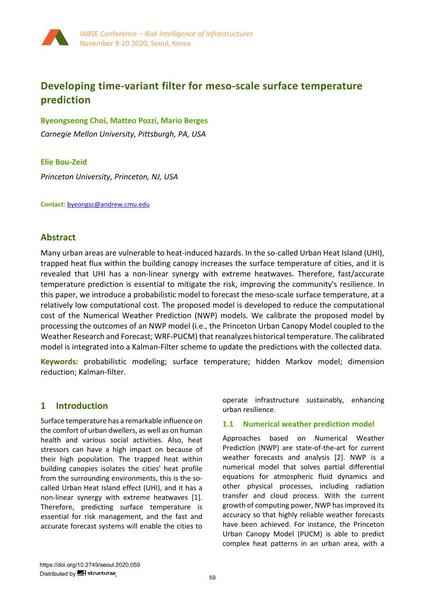Developing Time-Variant Filter for Meso-Scale Surface Temperature Prediction

|
|
|||||||||||
Détails bibliographiques
| Auteur(s): |
Byeongseong Choi
(Carnegie Mellon University, Pittsburgh, PA, USA)
Matteo Pozzi (Carnegie Mellon University, Pittsburgh, PA, USA) Mario Berges (Carnegie Mellon University, Pittsburgh, PA, USA) Elie Bou-Zeid (Princeton University, Princeton, NJ, USA) |
||||
|---|---|---|---|---|---|
| Médium: | papier de conférence | ||||
| Langue(s): | anglais | ||||
| Conférence: | IABSE Conference: Risk Intelligence of Infrastructures, Seoul, South Korea, 9-10 November 2020 | ||||
| Publié dans: | IABSE Conference Seoul 2020 | ||||
|
|||||
| Page(s): | 59-65 | ||||
| Nombre total de pages (du PDF): | 7 | ||||
| DOI: | 10.2749/seoul.2020.059 | ||||
| Abstrait: |
Many urban areas are vulnerable to heat-induced hazards. In the so-called Urban Heat Island (UHI), trapped heat flux within the building canopy increases the surface temperature of cities, and it is revealed that UHI has a non-linear synergy with extreme heatwaves. Therefore, fast/accurate temperature prediction is essential to mitigate the risk, improving the community's resilience. In this paper, we introduce a probabilistic model to forecast the meso-scale surface temperature, at a relatively low computational cost. The proposed model is developed to reduce the computational cost of the Numerical Weather Prediction (NWP) models. We calibrate the proposed model by processing the outcomes of an NWP model (i.e., the Princeton Urban Canopy Model coupled to the Weather Research and Forecast; WRF-PUCM) that reanalyzes historical temperature. The calibrated model is integrated into a Kalman-Filter scheme to update the predictions with the collected data. |
||||
